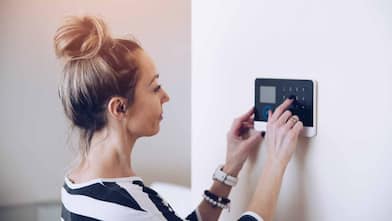Highlights
Distance automations can turn on or off certain smart security devices.
Smart home automations will alert you to security camera activity.
Smart home automations can alert emergency services when necessary.
There’s nothing worse than being on vacation and realizing you forgot to lock the back door or left your curling iron plugged in. Luckily, there’s plenty of smart home technology that can help you ensure that your home is safe and sound when you’re away.
Home automation can relieve some of the stress of remembering to turn on outdoor lights, lock and close doors, and even detect smoke and carbon monoxide promptly. Check out these smart home devices that make protecting your home much easier—and make it clear that smart homes are worth the money.
1. Locking the Door When You’re Away
Whether you’re rushing out the door to bring the kids to school or going for a quick jog, you can use smart home locks to lock the door behind you. Since the smart lock is controlled by an app or your smartphone or another Wi-Fi-connected device, you can set a distance your phone may travel outside of the house before locking the doors. For example, if you’re two miles down the road, the lock will detect you’ve gone far enough without locking the front door and will do it automatically.
2. Turning On Lights From Afar
While simple in nature, forgetting to turn on your indoor and outdoor lights may make your home susceptible to unwanted visitors. A quick and easy home automation is to use a smart light with a timer to schedule lights to come on at a certain time to give the presence that you’re home, even if you’re not. Many smart lights can detect when the sun rises and sets, which avoids wasting electricity throughout the day.
3. Detecting Smoke and Carbon Monoxide
Smoke and carbon monoxide are dangerous gases that pose a significant health risk if detected in your home. Luckily, you can worry less once you install smart smoke and carbon monoxide detectors that alert emergency services if too much of either gas is in your home. Certain models even pair with a garage door opener to automatically open the garage, allowing the smoke and carbon monoxide to leave the house quickly.
4. Closing the Garage Door
Speaking of garage doors, it’s almost too easy to pull out of the driveway and forget to close it behind you. Plus, sometimes that pesky clicker doesn’t do the trick and you’re stuck wondering if the garage door closed.
With home automation technology, you can monitor your garage door from afar using a smart garage door opener. Using an app on your smart device, you can open or close the garage door, as well as monitor activity outside of it. This handy smart home device helps with theft protection and lowers your garage door energy usage.
5. Turning Off Live Outlets
With so many devices plugged into your outlets these days, it can be tough to remember to unplug everything before you leave the house. To keep your appliances from overheating or causing damage, install smart plugs that you can control and monitor from your smart device.
Plus, some smart plug models have automatic turn-off features similar to smart door locks. For instance, say you wanted the house to smell nice and you put on a wax melt, but then left to grab a bite to eat. If your phone travels too far from the house, the smart plug will automatically turn off, cutting power to the appliance that’s plugged in.
6. Monitoring Kitchen Appliances
Smart home appliances, including washers, dryers, ovens, and even fridges, keep your kitchen running smoothly, even if you’re not in it. You can monitor the temperature or usage of these smart appliances from your smart device, and it’ll alert you of any changes.
For example, suppose you need to grab something from the grocery store while your dinner cooks in the oven. Once the smart device recognizes that you’re outside the home, it will send you an alert to let you know the oven is still on, allowing you to make a decision about whether to turn it off while you’re away. That way, you won’t come back to a ruined dinner or a ruined house.

7. Alerting You to Activity on the Security Camera
Indoor and outdoor security cameras are a great way to increase the security of your home, but unless you constantly check the footage, you may miss some sneaky figures (human or animal). Instead of skimming through footage, you can program your smart security camera system to send an alert to your smartphone or other device whenever it detects movement.
Some smart home security cameras can even tell the difference between people, animals, vehicles, and packages. Certain security cameras, such as doorbells or two-way cameras, allow you to speak or play noises so you can communicate with the person at your door.
8. Looking Out for Floods
Do you live in an area where heavy rain and flooding happens often? Smart home automation allows you to set up water leak sensors to detect the presence of water in a basement, crawl space, or even inside your walls. If the device detects high water levels, it’ll send you an alert and shut off the water, if it’s connected to a Wi-Fi-enabled shut-off valve. This automation protects your home by stopping the flow of water before it reaches damaging levels.
9. Monitoring Your Pool’s pH Levels
The pool is an area for fun and relaxation, so when the water’s pH levels get out of whack, it can ruin the experience for everyone. To avoid a pool party fiasco, use automated chemical testing to monitor the pool’s pH levels. The smart system will alert you if the pool is running low on the necessary chemicals, so you can restock before the water reaches critical levels.





